Description
Balto – Dog Knee Brace – BT JUMP
PURPOSE
The Balto Dog Knee Brace, known as BT JUMP, is specifically designed to address various knee joint conditions in dogs, including cruciate ligament rupture (ACL), luxation of the patella, arthritis, and arthrosis. It serves as an effective solution both as an alternative to surgery and during post-surgery recovery (TTO, TTA, TPLO, DeAngelis, tie rope, extracapsular procedures).
Key Features:
The BT JUMP knee brace features two pockets that house removable splints made of laser-cut alloy. These splints are strategically placed to restrict knee movement and provide stability to the affected joint during the recovery period.
Optimal Fit:
To ensure proper placement, the brace includes an abdominal band that securely positions it at the correct height on the leg. In situations where the abdominal band is not suitable, an alternative “anchor kit” is provided, which can be worn dorsally and attached to the uninjured, contralateral leg. Additionally, an optional “Collar Link” is included to prevent any sliding of the abdominal belt or anchor kit.
Comprehensive Kit:
When purchasing the BT JUMP knee brace, you will receive a complete kit that includes the brace itself, the removable splints, the collar link, the abdominal belt, and the anchor kit. Please note that the anchor kit is not available for size XXS.
Versatile Use:
In addition to its primary purpose, the BT JUMP knee brace can also be utilized without the splints for dogs suffering from conditions such as arthritis. The pressure provided by the brace improves blood circulation, thereby raising the temperature and reducing pain associated with these conditions.
The Balto Dog Knee Brace – BT JUMP offers a practical and versatile solution for addressing various knee joint issues in dogs, promoting their comfort and aiding in their recovery.
SIZES AND MEASUREMENTS
Before making a purchase, it is essential to accurately measure your dog using the guidelines provided below. If you have any uncertainties, please feel free to contact us via email and provide the following information:
- Measurements (A, H)
- Weight of your pet
- Breed of your pet
- A photo of your dog
Measurement A:
- Do not measure on the knee or in the groin area.
- Measure the circumference of the leg at the midpoint between the knee and groin.
- Ensure the leg is fully extended and the dog is standing. If your dog is experiencing pain and lifting the injured leg, please measure the unaffected leg as a reference.
Measurement H:
- Similar to measuring a child against a wall.
- Position your dog against a wall and use a book or object to slide against the rump/lumbar spine (above the hind legs) to make a pencil mark on the wall.
- Measure the distance from the floor to the pencil mark on the wall.
- Note: Dogs with a sore leg for an extended period may develop a rounded back to alleviate pain. A relaxation massage can help resolve a rounded back.
If the back remains rounded, please measure H near the base of the tail or provide us with a picture of your dog with the measuring tape next to them.
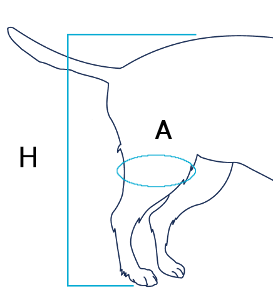
| Size | Circumference A | Height H |
Weight |
| XXS | 10-16cm / 3.9-6.3in | 20-26cm / 7.9-10.2in | 3-6kg / 6.6-13.2lb |
| XS | 16-19cm / 6.3-7.5in | 26-38cm / 10.2-15in | 5-10kg / 11-22lb |
| S | 21-26cm / 8.2-10.2in | 38-48cm / 15-18.9in | 10-20kg / 22-44lb |
| M | 26-31cm / 10.2-12.2in | 48-60cm / 18.9-23.6in | 15-30kg / 33-66lb |
| L | 29-38cm / 11.4-15in | 60-70cm / 23.6-27.5in | 28-45kg / 61.7-99.2lb |
| XL | 36-45cm / 14.2-17.7in | 68-78 cm / 26.7-30.7in | 45-62kg / 99.2-137lb |
EXAMPLE OF BREEDS
IMPORTANT
Note: Please do not select the brace size based solely on the examples below. Accurate measurement of your dog is necessary.
- XXS (CATS and TINY DOG): Pomeranians, Chihuahuas
- XS (SMALL DOGS): Jack Russell, Shih Tzu
- S (MIDSIZE DOGS): Beagle, Cocker Spaniel, French Bulldog
- M (MEDIUM DOGS): Border Collie, Bulldog, Kelpie
- L (LARGE DOGS): German Shepherd, Labrador/Golden Retriever, Rottweiler, Doberman
- XL (GIANT DOGS): Bullmastiff, Great Dane, Large Rottweiler, and Doberman…
POTENTIAL SIZE INCOMPATIBILITY
Please note that our dog knee brace is specifically designed for dogs with standard leg proportions (size/shape).
It is crucial that all three measurements (A, H, Weight) indicate the same size category according to the provided size chart.
If any of the measurements you obtain do not correspond to the same size category, it may indicate potential size incompatibility. This is particularly relevant for dogs with short legs and large thighs, as they may require special consideration.
In such cases, we kindly request you to email us pictures of the measurements you took, along with the breed and weight of your dog, at [email protected]. This will enable us to assess the measurements and provide personalized assistance in selecting the appropriate size for your dog.
Examples of breeds that may require special attention due to potential size variations include Bulldog, Bull Terrier, Westie, Cairn, Basset Hound, and Corgi.
CHOOSE THE CORRECT SIDE
IMPORTANT
Please note the following important information when selecting the appropriate side for the dog knee brace:
If you are standing behind your dog and looking in the same direction, the right leg refers to the leg on your right side. Similarly, the left leg corresponds to the leg on your left side.
For clarity, in the main photograph displayed above, the dog is wearing the brace on its RIGHT LEG.
THE NEED FOR RIGID SPLINTS IN A DOG KNEE BRACE
One of the key features of the BT-JUMP Dog Knee Brace is the inclusion of two angled lateral aluminum splints.
These splints serve a vital purpose in promoting stability and facilitating the healing of scar tissue around the knee joint during the recovery process.
By strategically placing the splints on the sides of the brace, they provide structural support to the knee, limiting excessive movement and promoting proper alignment. This controlled restriction aids in the formation of snug scar tissue, which is essential for stabilizing the knee joint.
FITTING THE BALTO KNEE BRACE
To ensure the proper fit of the Balto Knee Brace, follow these steps:
- Identify the different components of the brace, including the abdominal belt, collar link, anchor kit (if applicable), and the brace itself with its straps.
- Locate your dog’s patella or knee cap. The hole of the brace should be centered on the knee cap.
- It is easier to fit the brace when your dog is standing.
- Open the abdominal belt and secure it around your dog’s belly. Adjust the tightness to position the knee brace at the correct level on the leg.
- Open all the straps of the brace and place it on the knee, ensuring that the hole is centered on the patella.
- Starting from the top, close one strap at a time. Note that smaller breeds (XXS and XS sizes) may have only one knee strap. Adjust the abdominal belt slightly tighter if needed.
- When sitting or lying down, your dog’s leg should be straight. If the brace slides down or if the dog flexes its leg while sitting or lying down, it indicates that the brace is too loose.
- If your dog tends to lift or drag its leg instead of bearing weight on it while walking, check the lowest strap near the hock. It may be too tight, so loosen it slightly to relieve pressure on the tendon.
- For breeds with long hair, clipping the hair may be necessary to ensure a better fit of the brace.
RECOMMENDATIONS FOR USE:
- During the period of restraint, avoid leaving your dog alone for extended periods as they may attempt to remove the brace by biting or scratching it.
- Be cautious when applying the brace to a male dog to avoid compressing the urethra. Pass the abdominal belt in front of the foreskin to prevent discomfort.
- It is recommended to supervise your dog at all times while wearing the brace to prevent damage to the brace or self-injury.
ABDOMINAL BELT POSITION:
- On male dogs, the abdominal belt can be positioned in front of or over the penis. The belt fabric is soft and comfortable to prevent skin irritation.
- Check twice a day to ensure a comfortable fit. Avoid over-tightening the belt to prevent rubbing.
- Overweight dogs may experience issues due to the lower hanging abdomen, which can exert extra pressure against the belt.
OPTIONAL OVERWEIGHT MALE DOG ADAPTOR (ANCHOR KIT):
- The Balto braces are designed to fit both male and female dogs.
- In cases of overweight male dogs, an optional Male Adaptor is available for use.
- Refer to the provided video for instructions on using the Male Adaptor.
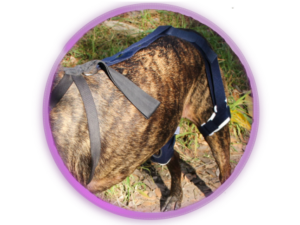
USEFUL INFORMATION
SURGERY or DOG LEG BRACE – Watch this video
RECOMMENDED ACTIVITY LEVEL
During the recovery period, it is important to adjust your dog’s activity level to aid in the healing process. Here are some recommendations:
- Consult with a qualified canine rehabilitation practitioner with a CCRP or CCRT qualification. They can create a specific protocol and home exercise program tailored to your dog’s needs and level of recovery.
- Start with short, slow walks on a short lead for about 5 minutes, twice a day. Walking on flat ground in straight lines is ideal.
- Gradually increase the duration of walks and introduce different types of ground surfaces.
- For small breeds that tend to speed up on three legs, walking on gravel can help slow them down.
- Weight-shifting exercises can be beneficial in rebuilding trust in the affected leg. While your dog is standing with the brace on, gently push the bottom from left to right, encouraging weight-bearing on each leg.
- Hydrotherapy is a great option, but swimming should be introduced cautiously. Begin with walking in water before progressing to swimming. Monitor playtime with other dogs and avoid jumping or running for 1 to 3 months.
FACTORS ACTING ON HOW LONG TO USE THE KNEE BRACE
Several factors can influence how long the knee brace needs to be used:
- The severity of the tear, whether it is partial or total.
- The presence of other leg damage, such as collateral ligament or meniscus injuries, patella luxation, or hip, back, or hock strains/sprains.
- The weight of your dog, with smaller breeds under 10kg generally showing faster improvement compared to larger breeds or overweight dogs.
STATISTICS REGARDING THE BALTO DOG KNEE BRACE
- It typically takes 1 to 3 months for scar tissue to stabilize the stifle, allowing the dog to walk without the brace.
- During this initial period, it is advised to use the brace whenever the dog is active, removing it at night or during rest.
- After the first phase, the scar tissue requires an additional 6 months to consolidate and become strong enough to bear the full weight of an active pet without the brace. During this phase, the brace can be used only during times of increased activity.
- The BT-JUMP-DUAL dog knee brace is designed to lower the risk of a cruciate injury in the second leg, especially for overweight and older dogs.
- The brace provides external support but can still be chewed or scratched by the dog. Remove the brace when leaving the dog alone to prevent damage.
- Check your dog’s skin twice a day where it contacts the brace to ensure there are no rubbing or irritation issues. Adjust the straps if needed and reduce brace wearing time to allow irritated skin to heal.
- Supervision is recommended at all times when the dog is wearing the brace to prevent damage or self-injury.
ADAPTATION PERIOD
Most dogs adapt to the knee brace easily within a few minutes or hours. However, if your dog has difficulty adjusting, follow these steps:
-
- Double-check the fitting to ensure it is correct.
- Assist your dog with weight-shifting exercises, as described earlier.
- Provide treats and rewards to encourage your dog while wearing the brace.
- Start with short intervals of 15 minutes, several times on the first day. Gradually increase the wearing time to 1 hour, then 2 hours, 3-4 times a day in the following days.
- Alternatively, remove the splints from the brace for a few days while your dog is getting used to the brace, then slide them back inside their pockets few days later.
CARING FOR YOUR BALTO KNEE BRACE
If needed, you can wash the brace gently by hand using soap and warm water (temperature below 30°C or 85°F). Ensure the brace is completely dry before fitting it on your dog to prevent infections.
SINGLE OR DUAL DOG KNEE BRACE?
The use of a single or dual brace depends on the specific situation and needs of your dog. Here’s some information regarding the choice between a single or dual brace:
- It is common for dogs with a damaged cruciate ligament in one leg to also experience a similar injury in the opposite hind leg, with incidence rates ranging from 50% to 80% during the immediate months to 2 years.
- The weight of your dog. It becomes more difficult to nurse a heavy when both legs are affected because they are not as easily lifted as small breed dogs.
- With age, every dog develop arthritis and while only one leg might be injured, the other one could benefit from additional support, particularly if affected by arthritis.
Balto offers the BT-JUMP knee brace, which can be used as a single brace on each leg. Additionally, these single braces can be assembled together to form a double knee brace called the The BT-JUMP-DUAL dog knee brace.
Exception for smaller breeds: The BT-JUMP-XXS brace, designed for smaller breeds, does not have an internal ring and therefore cannot be used as part of a dual brace config
UNDERSTAND THE CRUTIATE INJURY AND TREATMENT OPTIONS:
WHAT IS A DOG CRUCIATE LIGAMENT INJURY?
A dog cruciate ligament injury refers to the rupture or damage of the cruciate ligament in the knee joint of a dog. The cruciate ligament is responsible for providing stability to the knee joint, particularly when the dog bears weight on its leg. When the ligament is ruptured, the knee joint becomes unstable.
The immediate effects of a cruciate ligament injury include pain and swelling in the affected knee. The dog may experience lameness or have difficulty putting weight on the injured leg. Over time, if the injury is not properly treated, a lack of activity and the instability of the knee joint can lead to muscle wastage or atrophy.
However, the long-term consequences of a cruciate ligament injury are even more significant. Without proper stabilization and treatment, the instability in the knee joint can contribute to the development of osteoarthritis. Osteoarthritis is a degenerative joint condition characterized by the breakdown of cartilage and inflammation in the joint, leading to chronic pain, stiffness, and reduced mobility.
BALTO DOG KNEE BRACE AS AN ALTERNATIVE TREATMENT TO ACL SURGERY
Learn More about all the treatment options for a dog cruciate ligament injury
The Balto dog knee brace, such as the BT-JUMP model, can serve as an alternative treatment to ACL (anterior cruciate ligament) surgery for dogs with knee joint instability. While surgery performed by a veterinarian can involve internal support like tie ropes, screws, or plates to stabilize the knee joint, knee braces offer external support to address joint instability.
The BT-JUMP dog knee brace is specifically designed to provide support to the knee joint. It features two splints made of aluminum that are inserted into the comfortable and padded fabric of the brace. These splints help restrict movement and provide stability to the affected knee, aiding in the recovery process. The brace is adjustable and can be securely fastened using straps to ensure a proper fit.
By using a knee brace like the BT-JUMP, dog owners can provide external support to settle joint instability and aid in the healing process, especially for cases where surgery is not the preferred option or not immediately feasible. However, it is important to consult with a veterinarian to determine the most appropriate treatment approach for your dog’s specific condition. The veterinarian can provide guidance on whether a knee brace is suitable and effective as an alternative to ACL surgery in your dog’s case.
BALTO DOG KNEE BRACE AS A SUPPORT FOR POST SURGERY
The Balto dog knee brace can also serve as a support for dogs recovering from stifle surgery, including procedures such as the tie rope technique, TTO (tibial tuberosity advancement), TTA (tibial tuberosity advancement), TPLO (tibial plateau leveling osteotomy), D’Angelis technique, extra-capsular imbrication technique, luxating patella surgery, and Tibial Crest Transposition.
After stifle surgery, the knee joint may be painful and swollen due to the implant used to stabilize the joint. During the initial 2-3 weeks following surgery, it is crucial to ensure the dog’s activity is restricted to prevent excessive stress on the surgical site, which could potentially damage the corrective work.
While some dogs may be easy to manage and naturally have reduced activity levels during the recovery period, others may become restless or have difficulty adapting to restricted activity. In such cases, a knee brace like the Balto dog knee brace can be used to provide additional support and protection to the surgery site.
The knee brace should not be worn continuously but rather used selectively when you are unable to restrain the activity level of your dog. By using the knee brace during periods of increased activity, you can help support the knee joint, minimize the risk of injury, and aid in the healing process.
It’s important to consult with your veterinarian to determine the appropriate usage of the knee brace and to receive guidance on post-surgery care and activity restrictions specific to your dog’s condition.
UNDERSTAND THE LUXATING PATELLA AND TREATMENT OPTIONS:
Luxating patella, also known as a floating kneecap, is a condition where the kneecap (patella) moves out of its normal position within the groove of the thigh bone (femur). It is a common orthopedic issue in dogs, particularly small breeds. Luxating patella can cause pain, lameness, and difficulty in walking or running.
While the Balto dog knee brace provides support and stability for dogs with cruciate ligament injuries or post-surgery, it is important to note that it is not considered an alternative to the surgical. The knee brace can provide temporary relief and support for the affected knee, but it does not correct the underlying problem.
The primary treatment for luxating patella is surgical intervention. The specific surgical technique depends on the severity of the condition and other factors. Surgical options may include realignment of the patella groove, tightening or reconstructing ligaments, and addressing any associated abnormalities.
DOWNLOADS
View BALTO Product Catalog

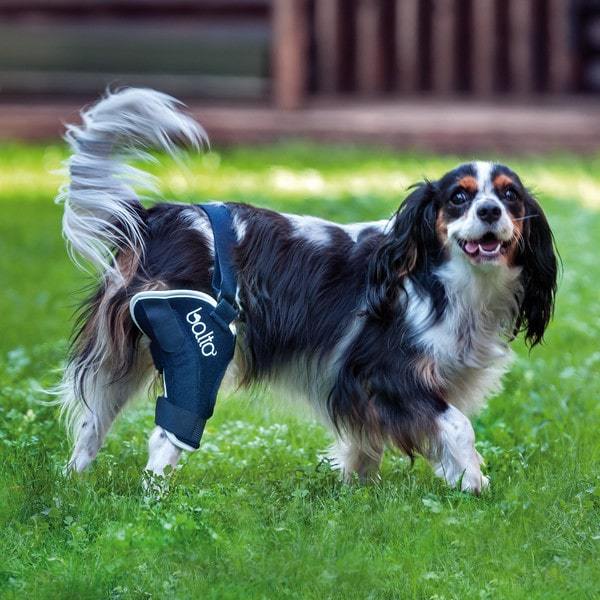
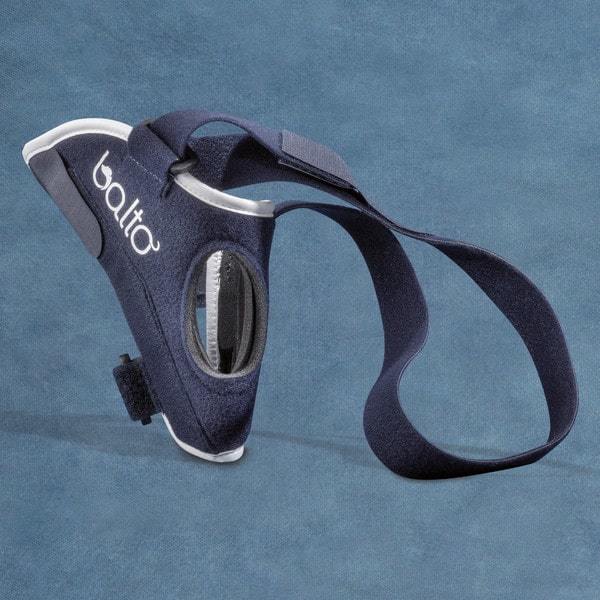

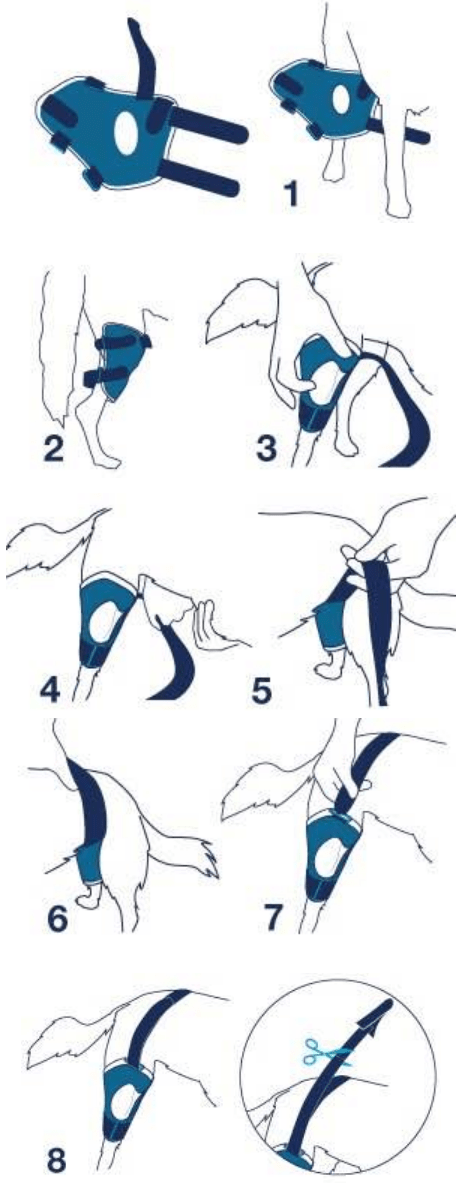
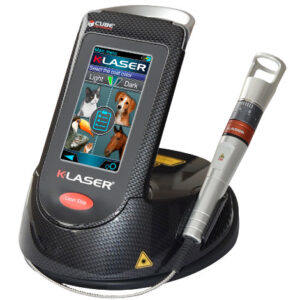
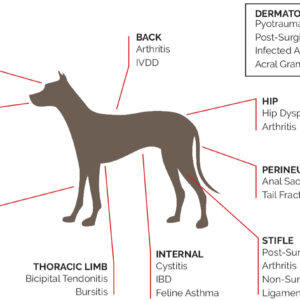
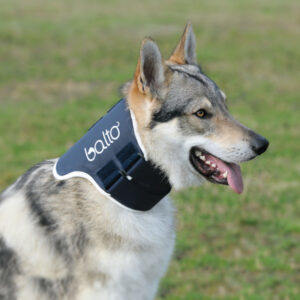
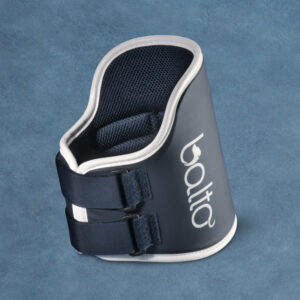
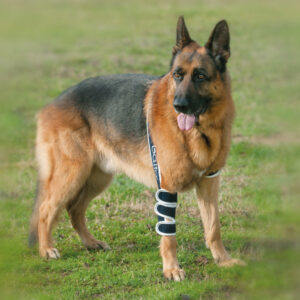
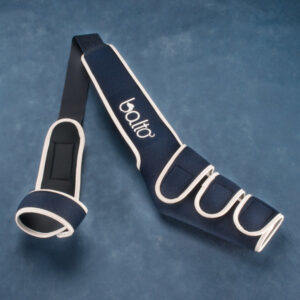
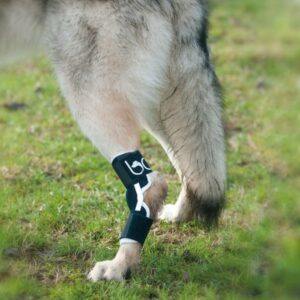
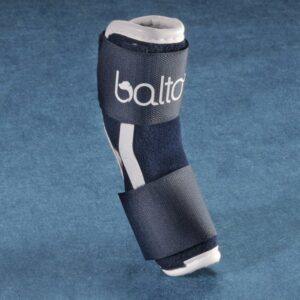
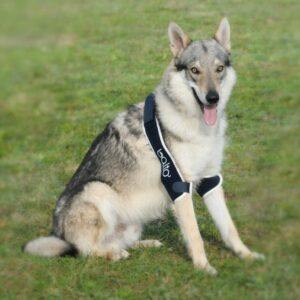
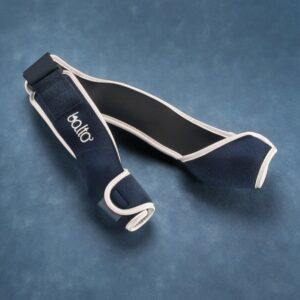
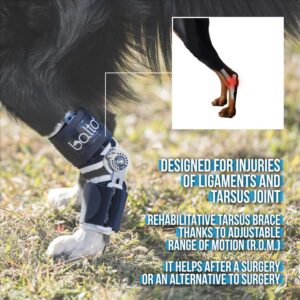
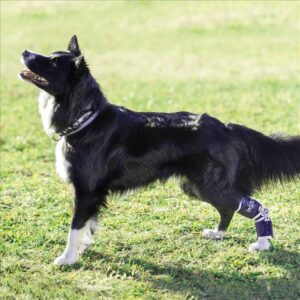
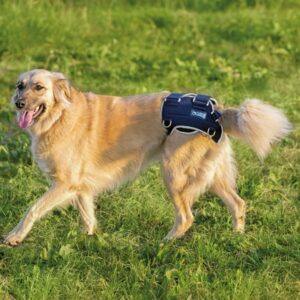
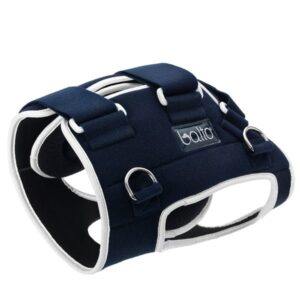
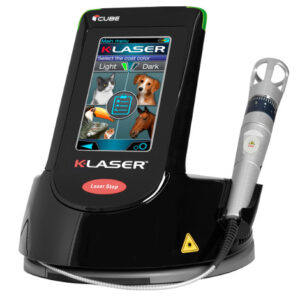
Troy –
The brace was used as part of an alternative treatment to surgery for a torn ACL on a Jack Russell Terrier. It was easy to fit and straight away my girl was able to put weight on her injured leg. With frequent use, hydrotherapy and light exercise she is on track to a full recovery. I would recommend this product to all dog owners whos best mate has suffered a knee injury.
Troy
Rob and Rocco –
G’day
Thank you for such a wonderful product.
Our miniature poodle was limping and favoring his back left leg. A vet said it was a torn crucial ligament and the operation was very expensive with a very long recovery so we decided to try the Balto Dog Knee Brace. We use it when we take him for walks, especially if we suspect he might run. After four weeks he is not limping and is putting weight on his bad leg. We are still being very careful with him but his recovery has been amazing. We will make sure he keeps wearing it for at least another month on his walks. I would recommend the Balto Dog Knee Brace to anyone.
Kind regards Rob and Rocco
Howard –
We bought the brace for our female Jack Russell, who had a ruptured cruciate ligament injury.
It has been quite successful as part of her treatment, and we have avoided surgery. She has made good progress to this point.
It is quite easy to fit and she does not mind wearing it. We had to add some padding around the bottom to stop rubbing, and the strap tends to slide off her back. We solved this problem by using a safety pin to pin the strap to her coat, which she mostly wears.
Our vet was quite pleased with the design.
As part of a coordinated recovery program of rest, anti-inflammatories, and gradual reintroduction of exercise, I would definitely say that the brace has been worthwhile. Regards
Howard
Tracy –
The knee brace is awesome and the most reasonably priced. We received it before the set dates. It was a good fit, unfortunately, we are having to put our beloved Abraham to sleep tomorrow, which breaks my heart. Due to the fact that he is 13 he is not a good candidate for surgery so his health has declined rapidly in the last week. Thank you for a great product.
Tracy
Melissa –
We bought a knee brace for our 11-year-old lab x beagle, Bosco, who tore a cruciate ligament about 6 weeks ago. We hesitate to put him through surgery, due to his age.
Initially, Bosco couldn’t put any weight on his injured leg. But since using the brace, mainly only when going for short walks, he is much stronger in the injured leg, and the brace is also helping to take some of the pressure off his good leg. He can now walk up a couple of stairs again, and even jump on our bed. J
I would highly recommend trying the brace if surgery isn’t an option. Or maybe even before surgery, and for post-op recovery?
Thanks, Alpha Mobility Solutions.
Melissa
Francesca –
Firstly the Knee Brace I bought for my dog (right knee Crucial Ligament) from your Company was easy to use, once I finally read the instructions ;-).
I only use it when my dog jumps around a whole lot and it helps tremendously, the first time she had it on she wasn’t game to move, but now she wears it and walks easily with it on.
So I guess that makes me happy with the Results it Gives to My Dog.
And I have Recommended the Balto Knee Brace and your Company to my Veterinary Service and have given my Vet your card, as I took the Brace in to show her. She said that she had other Dogs with some kind of damage or pain and would suggest it to their owners.
Sincerely,
Francesca
Shirley –
After 1 month use: The dog knee brace has worked wonders. I have kept the brace on Buster all day everyday and only take it off at night. He has had it off all day today and is walking without a limp at all. I will see how he goes again tomorrow and if he is still able to use his leg normally I will then only use the brace when he is going for long walks or running. I am so happy thank you so much.
Shirley
Shirley –
I am so happy with the results achieved by using the Balto Brace. My boy Buster had a severe cruciate ligament injury and was looking at surgery as an only answer. I discovered the Balto Brace on the Internet and decided to give it a try. After several weeks of wearing it all day and only having it off at night while sleeping Buster is back to his happy self no limp and no pain. I am amazed at the results.
Thank you so much.
Shirley
Tom –
We have a Golden Retriever with cancer in the left front leg. We decided to let her live out her life since she is 12 years old instead of having it amputated. The brace is being used successfully to provide support for her weakened leg and to relieve pain. It is working very well.
Tom, Delaware, USA
Steve –
Hey yall,
I just wanted to tell yall thanks. I’m very impressed with how fast this item shipped and the immediate quality of the product I received. Upon putting the brace on my dog and following the instructions on the box and online I noticed how well it fit and how well it adjusted to my dog. She quickly adapted to the brace and after a full afternoon of her trotting around the yard I have yet to see it slip down her leg nor does it seem to bother her. Praying this product helps naturally heal her partially torn ACL. Compared to other braces that are available (some around $700US or more and a month of waiting) for just over $100 bucks and fast shipping I’m very very impressed.
Thanks again yall!
Steve and Mugsy.
=> Slip problem is corrected by linking the back strap to the collar.
Karin –
How are you?
I received your braces today. I am extremely satisfied with them! I have been searching for the right braces for her for some time now. I was constantly “googling” images for “canine knee braces” and I became frustrated. As far as your product goes; there definitely weren’t enough photos on the web. Photos of dogs wearing them-at least not in the US! I purchase a lot of products online. Especially on Amazon.com. I rarely write reviews. But, my brother swears by them and goes by them religiously. Therefore, I’d like to offer to write a review about your braces.
I cannot get over the fact that my puggle started walking with them on and went outside to the bathroom with very little hesitation.
I’ll attach a bunch of photos that I took of Razin this evening. You are very welcome to use them. If you give me some instructions on how/where I can post my very positive review with pic’s that would be great as well. Such as pet forums, blogs, etc.
Thank you again. Karin
Post on dogkneeinjury.com
Brittany –
I wanted to share my appreciation for your well-designed braces. My dog tore his cruciate ligament in October just about as soon as we got to Colorado. All he was doing was running outside at our campsite. The next thing we knew he wouldn’t walk with his left leg down. We couldn’t, and still can’t afford a $4,000 surgery. We did our research and came across this amazing brand. As soon as we put it on him he was able to walk with his left leg again, but only with the brace on. After 2 months Nero could walk without the Balto brace. Now about 5 months out, we still make him wear it when we go for short hikes or if we know he’s going to be playful and be running around for protection. To be honest I think we’ll always make him wear it for those purposes as there is a noticeable difference when he wears it! Thank you for providing such excellent support for such a reasonable price. We don’t know what we would have done without it.
Brittany
Connie –
I just wanted to say thank you so much for your help on Christmas Eve with fitting a Balto Knee brace to my dog Scully. The vet specialist was recommending costly major surgery to “fix” her cruciate ligaments, but she is really coping very well with the Balto brace. While I have restricted her from climbing stairs, the brace allows her to quite happily go down stairs, walk and even run around the back yard and I’m only giving her some Chinese herbal pain medication once a day. She doesn’t seem to have any pain at all when wearing the brace and with the addition of some hydro-therapy to build up the muscle mass on that right hind leg, she is coming along really well. Thank you again, the brace is fantastic support for her leg!
Connie
Alison & Geoff –
We recently purchased a Balto knee brace for our dog, Sally. She has a ruptured cruciate ligament in her right back leg and we are trying to avoid surgery. When we received the brace, we watched the video and gave it a go. We find it a lot easier to put it on if we put the belly strap on first and loosely position the leg brace. We then position the leg brace, tighten the 2 leg velcros, then tighten the belly strap. Otherwise, you tend to end up with velcros getting stuck to each other and it gets messy and frustrating. Sally doesn’t seem to mind wearing the brace. I leave it on her all day and take it off in the evening. She puts weight on the leg and seems to enjoy light exercise. She relaxes in the lounge at night quite happily. If she doesn’t wear the brace all day, she gets quite cranky – obviously in pain. We would certainly recommend this item, although we haven’t had it long enough to know if it will fix our problem, but we will continue to use it.
Alison & Geoff
Maryann and Ray –
Received both Left and Right Large Balto knee braces Saturday. My husband had flown home from work to help fit it on our 110 lb. pup. We both thought it may prove a nightmare to fit. However, was rather simple. The hardest part was our big and wiggly dog who tried to lie down and hide the injured leg. Once we got it on it was a different story. Our Boo is not bothered by the brace and was literally instantly putting weight onto the injured limb. We left it on overnight as she has 24-hour access to our property and is fairly active keeping an eye on her territory. She has not shown any discomfort nor tried to chew or remove the brace. Once we figured out we needed to use the collar strap to keep the belly strap from slipping due to lying down etc. this brace has not moved or shifted.
Yesterday I ordered another pair (left and right) in the XL size. Our Boo hits the top range of Large fitting…and the Velcro straps that secure the brace around the knee joint are at their limit. But it is working fine….We are just hoping the XL may be a tad easier to put on and remove with longer straps that don’t catch up her fur as much when being engaged. So I suggest the measurement of “A” is very important (the “thigh”). Also, as a note; the collar strap has proven vital to keeping the brace stable. (We had to take the longer belly strap off the Left side brace we also bought… to fit the collar to belly strap length as the provided strap was way way too short to work.)
We have a large wiggly dog. Not easy customer to deal with so we rigged up a temporary “head and haunch no sit” grooming support that will keep her standing while we remove and place the brace. Takes only a minute or so to fit once we became familiar with the brace. I do suggest the collar strap is very important. It keeps the belly strap from slipping backward with the change of position from lying to standing and general wiggling. The collar strap keeps the belly strap in place…that, in turn, keeps the brace itself from rotating or slipping out of the position of the knee joint.
I am so very pleased with this brace. Boo’s injured Right leg was a mess. Within a few minutes of applying the brace, she was relaxed and putting more weight on the leg. Was instantly noticeable. Last night (after applying the collar strap) she was able to get onto the couch for a nap. This has not been possible for many weeks.
I cannot praise this brace enough. Like a human knee brace, it seems the side supports provide instant relief as pressure is being taken off nerves and the joint is stabilized. We wait for the XL model and will give it some time before we apply the brace to the opposite leg.
With an inoperable knee injury, a brace was our only choice. I researched all available and did not like what I saw for many reasons. Then I found Balto. Highest marks from both of us and our Boo.
Maryann and Ray – CANADA
Julie Moore –
My border collie had ACL repair surgery about 1.5 weeks ago, and this brace has been a lifesaver. it has really helped her get around. she is bearing some weight now on the leg, still wearing the brace. The brace has had the added benefit of covering the staples in her thigh, keeping her from getting at them! I feel relief that she has the added support of the brace when she needs it. Great product, easy to put on. I wish there was something like this for my mother who broke her hip on the same day my dog had surgery!
Sandra KOVAC –
I purchased the Knee Brace for my 14-year-old toy poodle Scruffy who ruptured his cruciate ligament in June. The vet was adamant he would not operate due to his age and other health issues. After doing a lot of research myself, I came across your product and purchased it.
Firstly I was impressed to have received it the following day. Scruffy has been walking on 3 legs for almost 6 weeks and is exhausted. I have started using the leg brace slowly and the strength he has regained has been remarkable. I even managed to take him outside on gravel and go for a slow walk. He spends most of his time inside (especially now during winter in the Adelaide Hills). He is more comfortable and has regained his balance. I cannot thank you enough for what your product has achieved for my beautiful dog. I am so impressed and grateful as I just can’t give up on not trying to help my best friend.
Kind regards,
Sandra KOVAC – AUSTRALIA
Nicole –
Our 15-year-old Australian Shepard tore her CCL (right rear leg) at the start of January 2018. We bought the brace at the end of January and have been using it for 4 weeks now. In short, it has surpassed our expectations. We have moved from carrying Piper down the steps to having her able to walk down the ramp and then around the block. Immediately we noticed that the brace helped align her leg back under her body rather than ‘wobbling’ out to the side. She has put more weight on the leg, balancing the body weight and taking the excess strain off the good leg. The brace provides peace of mind for us and much needed support for our dog. Piper now ‘drops and rolls’ on the lawn and is able to be outside with our other dog. Money well spent! Thank you for a good website and a great product!
Nicole – OH/USA
Susanne Oswald –
Lilly is 8 1/2yrs old.
She is a Siberian Husky X about 3 yrs ago she snapped her left Cruciate Ligament and had surgery to repair that, whilst recovering from that surgery she damaged her Luxating Patella in her left leg and required surgery.8 months later she snapped her right Cruciate Ligament and required more surgery.
As we live on the Gold Coast walking on the beach is one of Lilly’s favorite things to do however because of the damage to her Patella this activity would often see her lame for a couple of days. I purchased the leg brace in an effort to give her left knee the stability to enable her to still be able to enjoy her beach walks/runs. It has been the best thing for her, no more lameness I would recommend the brace to anyone in the same situation.
Warm Regards.
Sue
Ed Moran –
Hi,
I just wanted to thank you, after 2 months of wearing brace daily, no running, some laser,(& massage), Mickey has regained muscle & is walking completely normally (as well as he can, for almost 12yrs old,&arthritis). We do give him Chondroitin-Glucosamine supplements, but he does not need Carpofin or loads of aspirin. Just 1 100 mg., daily. I wish we had known about this brace 5 years ago when we put him through a $5K operation. It may have negated that! (x-rays show screws& loosened, some), but he is even eager to get up &play.
Sorry for my “skepticism”!!!
Ed Moran,
Barbara –
We got the brace last night. Already our 14-year-old poodle is putting some weight on her injured leg. It is gratifying to see her regaining some mobility and we look forward to her continued improvement as she becomes accustomed to the brace. Thank you for an effective and affordable product!
Barbara
Tammy Smith –
I think it fits Charley, our JRT mix, perfectly. Now able to take her out other than to potty while doing conservative management.
Thankful for this brace.
Regina –
Hello Alfred,
I would like to thank you for taking the time to make sure it was the right fitting for my dog. Minks is using it and it seems to really support his leg.
Again thank you,
Regina
Julia –
Pleased to have received my brace for my little chi super fast!! It’s comfortable for her and gives her rest bite from her knee.. she walks with ease and is very happy to wear it. Really pleased with my purchase worth every penny and I would always recommend…. I did email fist before ordering which gave me more confidence in my purchase….. many thanks fab product!!
Hillary Lennons –
Hello,
I just wanted to say a massive thank you to the Alpha Mobility Team and especially Eve.
In 2018 our fur baby, Doug, tore his cruciate ligament. Being too old for surgery and it being very expensive, my husband and I were beside ourselves. We came across Alpha Mobility from a friend who swore by the product. So we ordered a knee brace and it has honestly been the best money we’ve ever spent.
In time, Doug was able to walk and play as he could before the injury.
A year later, Doug tore his other CL while playing fetch. We ordered the brace for the other leg straight away and Eve was so helpful with sizing.
Knowing that we have the braces makes the stress of having an injured dog a bit easier.
They are a little tricky to get on with a wriggly dog who refuses to put his leg down, but it’s definitely worth it.
Thanks again.
The Lennons
Dave Hampson –
Here is our boy Chuck enjoying being able to walk so much better now he has his new knee brace. You can see how happy he is to get a proper walk again.
Dave Hampson
Emanuela –
Hi, Dante is doing well and still wearing his brace after a month.
His leg was very sore and since then we have seen some good improvement. He is now well used to wear it.
Emanuela
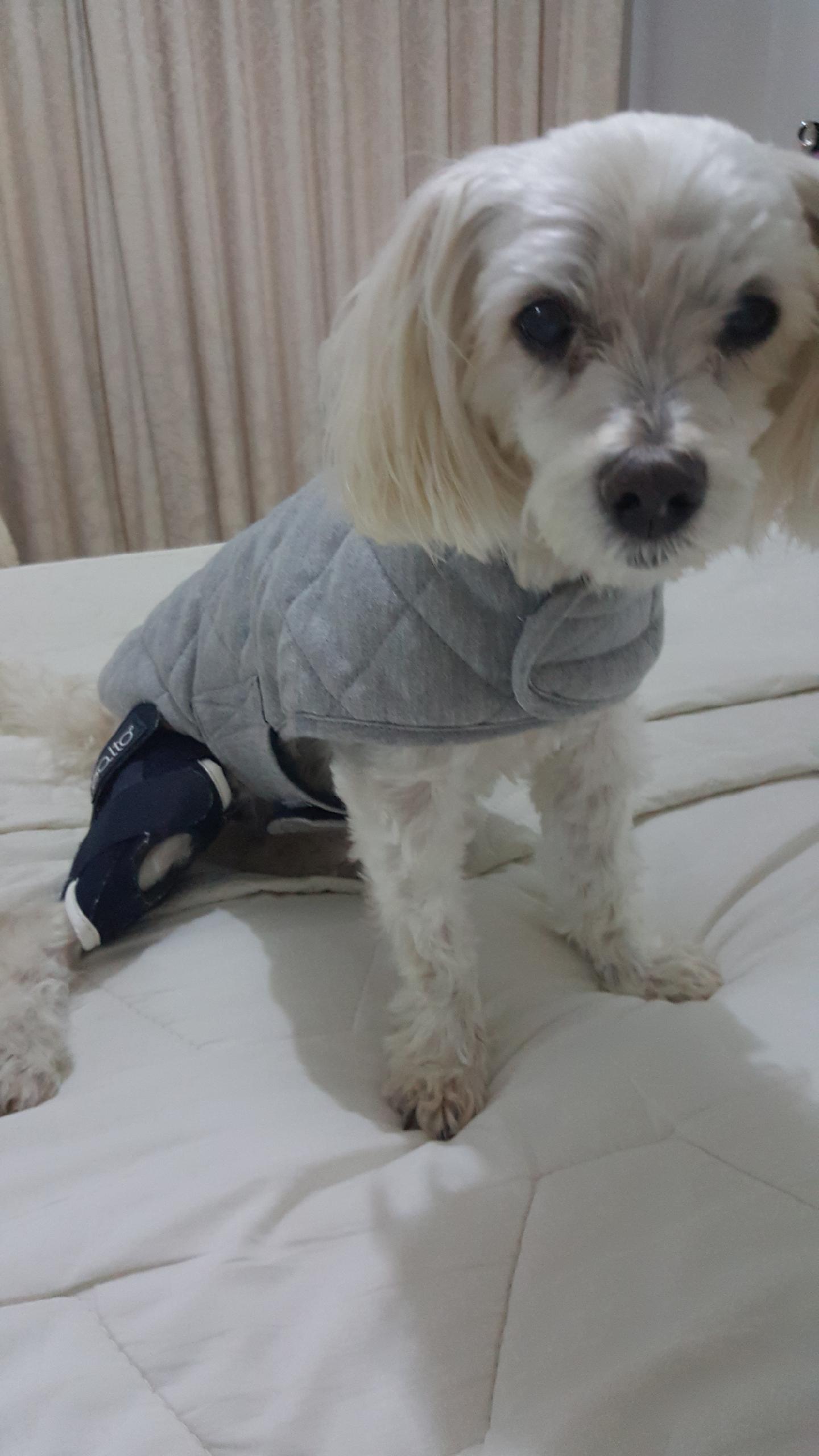
Shelley –
My BMD Ava, did really well with the Balto Knee Brace 2 years ago after ACL Rupture. No surgery necessary. Doesn’t need to wear it anymore. Great products. Shelley
Marci Bartu –
I purchased a brace for my dog’s left knee last year.
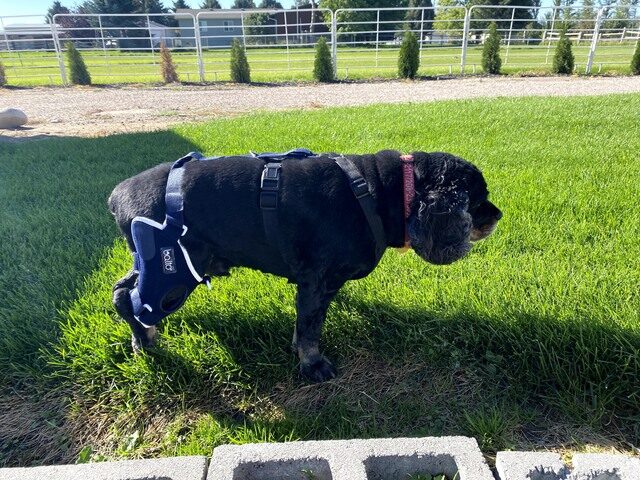
The brace helped that knee to heal and I was very pleased with the results so when his right knee was diagnosed with the same problem, I chose to go with the same treatment.
We use a harness to stabilize it instead of his collar because it pulled too much on his neck. Last year, we used the brace for about 6 weeks starting out with about 2 hours at a time and lengthening the time each day. He moved better with the brace and let us know by trying to rub it off when his knee quit hurting him. We never put it on him at night.
I am attaching pictures of my dog with his second Balto brace.
Marci
Laura (verified owner) –
Okay, this is exceptional service.
Thank you so much.
Yesterday we thought we were taking our dog to the vet to be put down after her second ACL went 18 months after the first. Instead, we found out from our vets that you can get braces, and then found you… so to receive such speedy service makes a huge difference to us and our pooch.
Many thanks,
Laura